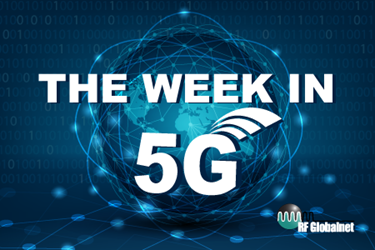The Week In 5G: 2/12/2019 – Verizon Launches Grassroots 5G Campaign, OEMs To Unveil 5G Phones At MWC
By Jof Enriquez,
Follow me on Twitter @jofenriq

Verizon is launching a grassroots campaign to make it easier for consumers to enjoin local officials to approve policies friendly to 5G deployment in their communities.
The "Let's 5G!" website includes information about 5G, as well as template letters and petitions that consumers can sign — and then send to local elected officials — to show support for establishing 5G networks in their neighborhoods, reported CNET.
"I support the immediate rollout of 5G wireless service in our community because of the benefits it will deliver today and the breakthroughs it will enable tomorrow," states one message template.
"5G has the potential to make really big waves in exciting and life-enhancing spaces such as artificial intelligence, education, healthcare, robotics, virtual reality, augmented reality, autonomous vehicles, wearables and the Internet of Things (IoT)," states a Verizon press release.
Verizon's 5G Home broadband internet service went live in October and the carrier will partner with Samsung to release one of the first commercial 5G smartphones in the United States. Samsung is one of many OEMs planning to unveil 5G phones during Mobile World Congress (MWC) on Feb. 25-28, 2019, in Barcelona, Spain. The Korean manufacturer is speculated to showcase 3-4 phones during the event.
OnePlus is set to unveil a gaming-centric 5G prototype device powered by the Snapdragon 855 chipset and Qualcomm’s X50 5G modem for 5G-connectivity, reported 9to5Google.
Huawei is expected to launch a 5G-capable folding phone at the event, and Nokia, Oppo, Sony and Xiaomi also plan to make their mark at the world's largest annual mobile industry show, according to CNET.
LG will attempt to steal everyone's thunder by announcing its 5G handset a day before MWC formally kicks off, reported 5G.co.uk. The device is likely to feature Qualcomm's top-end Snapdragon 855 chipset, a vapor-chamber cooling system, a 4,000mAh battery, and matching software to minimize battery drain, which can be substantial in the earliest 5G models to hit the market. The report, however, notes that Samsung can beat LG to the punch, with a 5G version of the Galaxy S10 possibly being announced on Feb. 20.
Unlike its Android competitors, Apple is not expected to launch a 5G-capable iPhone until 2020. In the meantime, the company reportedly is testing Intel chips and developing its own 5G modem ahead of the launch. Apple also may be preparing to conduct 5G testing, as evidenced by a trademark filing which, according to Venture Beat, includes a “figurative trademark” of an American flag with a “cartoony” bald eagle inside an Apple logo. The filing may be related to Apple's reported mobile network service within Benelux, which includes Belgium, the Netherlands, and Luxembourg.
In Switzerland, telcos Swisscom, Sunrise, and Salt paid a relatively modest 380 million Swiss francs ($379 million) for a block of frequencies in the 700 MHz, 1400 MHz, 2.6 GHz, and 3.5 GHz spectrum bands, according to Reuters. A fourth bidder, London-based newcomer Dense Air, dropped out of the auction. The amount raised in the Swiss auction is notably smaller than Italy’s 6.5 billion euros ($7.37 billion) 5G sale last year, while Germany could raise 4 billion to 5 billion euros in its 5G auction, stated the report.
Meanwhile, the Telecom Regulatory Authority of India is considering making available additional spectrum bands for 5G services, in addition to the 3300-3600 Mhz band it allocated for 5G in August 2018, according to The Economic Times. Specifically, authorities are looking at offering mmWave spectrum in the 28 GHz, 37 GHz, and 39 GHz bands. Also, they plan to set aside 140 Mhz spectrum for backhaul usage. The bands — E (71-76 GHz and 81-86 Ghz) and V (57-64 GHz) are widely used as backhaul, which means connecting the core of a telecom network to nodes and then onto towers to transmit data.
Australian carrier Optus is planning to deploy 1,200 5G sites in ACT (Australian Capital Territory), Victoria, New South Wales, Queensland, South Australia, and Western Australia by March 2020, reported RCR Wireless. In a Sydney suburb, it activated recently a 5G site running on Ericsson's 5G Radio Access Network equipment, a third-party customer premise equipment test device and Optus’ 3.5 GHz spectrum, with a channel bandwidth of 60 megahertz to achieve an end-to-end working solution in line with 3GPP standards.
Meanwhile, Thailand has launched a 5G test bed in cooperation with Huawei, the company’s first in Southeast Asia. The move was made despite pressure from the U.S. on its allies to shun Huawei amid spying allegations against the Chinese company.
"We keep a close watch on the allegations worldwide. However, this 5G test bed project is a testing period for the country," Thailand's Minister of Digital Economy Pichet Durongkaveroj told Reuters/CNBC at the launch in Chonburi, where other vendors like Nokia and Ericsson, as well as Thai telecoms operators, run their own 5G trials. "We can make observations which will be useful to either confirm or disconfirm the allegations."
Back in the U.S., Sprint has filed a lawsuit against AT&T over the latter's "false and misleading" 5G E (Evolution) advertising, reported ZDNet. AT&T recently began displaying the “5G E” logo indicators on its devices, implying that subscribers are on a true 5G network.
"AT&T has employed numerous deceptive tactics to mislead consumers into believing that it currently offers a coveted and highly anticipated fifth generation wireless network, known as 5G," stated Sprint’s complaint filed in the United States District Court Southern District of New York. "What AT&T touts as 5G, however, is nothing more than an enhanced fourth-generation Long-Term Evolution wireless service, known as 4G LTE Advanced, which is offered by all other major wireless carriers."
